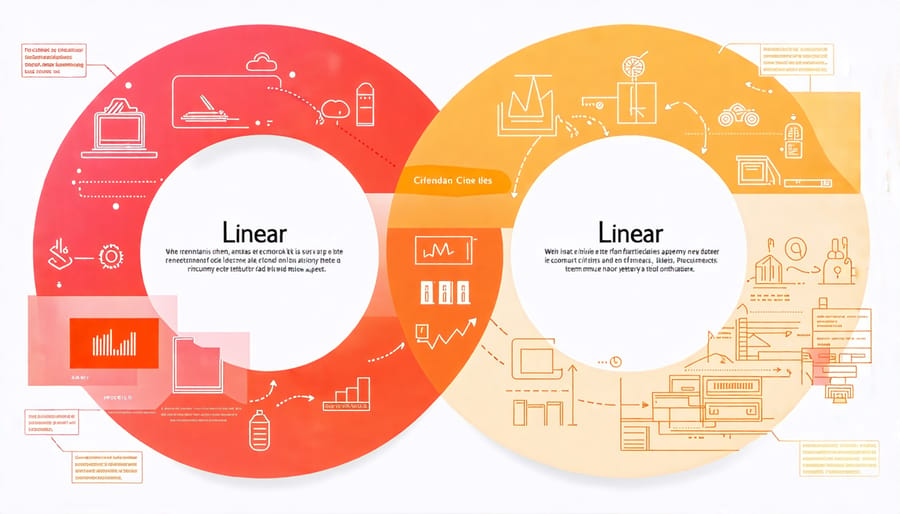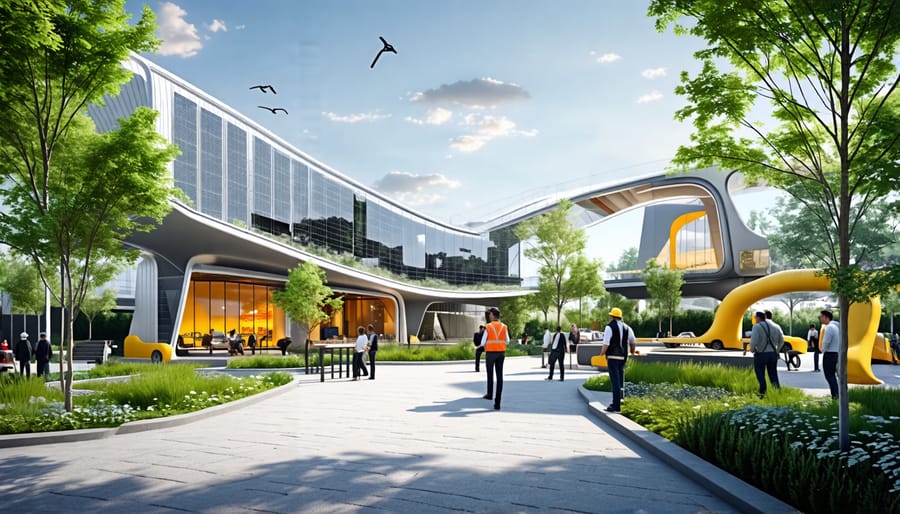Implement material reuse by sourcing reclaimed or recycled materials whenever possible to drastically reduce waste. Integrate design for disassembly principles in your projects to ensure components can be easily dismantled and reused, enhancing resource efficiency. Adopt innovative construction technology trends to streamline building processes and minimize resource consumption, aligning with circular principles. Construction technology trends offer crucial insights. Educate stakeholders on the economic and environmental benefits of a circular economy to foster collaboration and commitment across all project phases.
The Fundamentals of Circular Economy
Principles of Circular Economy
The circular economy in construction emphasizes three core principles: waste minimization, lifecycle extension, and resource efficiency. By prioritizing waste minimization, the industry can significantly reduce the environmental footprint of construction projects. Innovative zero waste initiatives enable construction professionals to strategically manage resources, ensuring that materials are reused or recycled rather than discarded.
Lifecycle extension involves designing buildings with durability and adaptability in mind, allowing structures to evolve with changing needs instead of being demolished and rebuilt. This principle encourages the use of modular designs and materials that can be easily repaired or upgraded. Resource efficiency is about optimizing the use of materials and energy throughout the construction process. It involves selecting sustainable materials, employing advanced technologies like Building Information Modeling (BIM) to minimize resource waste, and adopting energy-efficient practices.
By integrating these principles, construction leaders can drive sustainable practices, align with global environmental goals, and enhance long-term economic viability within the sector.

Comparing Linear and Circular Models
In the construction sector, traditional linear models follow a straightforward path: resources are extracted, utilized, and ultimately disposed of as waste. This extract-use-dispose method often leads to resource depletion and environmental degradation. In contrast, circular models prioritize sustainability by designing out waste and keeping materials in use for as long as possible.
Circular construction involves rethinking building processes to incorporate strategies like recycling, reusing, and refurbishing materials and structures. This approach reduces reliance on virgin materials and decreases carbon emissions, ensuring that buildings are adaptable and resources are continually repurposed. For instance, materials from deconstructed structures find new life in other projects, which not only minimizes waste but also reduces the demand for new materials.
Furthermore, circular models promote the durability and adaptability of buildings, encouraging designers to account for the entire lifecycle of materials right from the design phase. While linear methods might prioritize initial cost savings, circular approaches can lead to long-term economic benefits by reducing material costs and enhancing the value and lifespan of properties. This paradigm shift requires collaboration across the sector—architects, engineers, and project managers must all engage in innovative thinking to implement these sustainable practices effectively, forging a path towards a more resilient construction industry.
Innovative Techniques in Circular Construction
Recycled and Renewable Materials
The integration of recycled and renewable materials within construction projects is transforming the industry by promoting sustainability and reducing environmental impacts. Utilizing recycled materials such as steel, glass, and timber not only minimizes waste but also decreases the demand for virgin resources, leading to significant reductions in carbon emissions. These materials, often sourced from deconstructed buildings, are processed and repurposed, meeting or exceeding industry standards while fostering a more circular approach. Renewable materials, such as bamboo, hempcrete, and mycelium, offer additional benefits by being naturally replenished and energy-efficient. They provide thermal insulation and structural capabilities comparable to traditional materials while enhancing a building’s sustainability profile.
The adoption of these materials is further reinforced by successful case studies, where innovative architects and engineers have achieved remarkable reductions in the carbon footprint of new builds and renovations. These case studies highlight practical applications and inspire confidence in industry decision-makers to embrace circular economy principles. The shift towards recycled and renewable materials is not only a testament to engineering ingenuity but also crucial in addressing global environmental challenges, ensuring a more sustainable future for construction.

Modular Building and Prefabrication
Modular building and prefabrication are revolutionizing the construction industry by aligning closely with the principles of a circular economy. These approaches offer significant advantages in terms of waste reduction and resource efficiency. By utilizing controlled environments for manufacturing, modular and prefab designs ensure precision and minimize material waste. This process not only boosts productivity but also enhances the quality and sustainability of the built environment.
The modular systems’ ability to be disassembled and reused offers an innovative response to traditional construction methods, which often lead to material wastage and limited reuse potential. Components produced through prefabrication can be easily adapted or repurposed for new projects, offering a flexible approach that greatly extends the lifecycle of building materials. This adaptability is pivotal in creating resilient architectures that can evolve over time without exhausting resources or generating excessive waste.
In addition, modular and prefabrication methods significantly reduce construction time on-site, thereby lowering carbon emissions associated with traditional building processes. By embracing these techniques, the industry can effectively navigate the growing challenges of urbanization while upholding ecological integrity.
Industry experts highlight case studies where these practices have been successfully implemented. For instance, a recent project demonstrated how modular design facilitated a 50% faster construction timeline compared to conventional methods while achieving a reduction in on-site waste by up to 70%. Such projects underscore the potential of prefabrication to meet high sustainability standards, aligning with the circular economy’s ambition to create a regenerative and restorative industrial framework. Thus, modular construction not only represents a practical solution but also a transformative advancement in shaping a sustainable future for the construction industry.

Case Studies: Circular Economy Success in Construction
In recent years, the construction industry has been undergoing a paradigm shift with the adoption of circular economy principles, a concept that emphasizes designing out waste, keeping resources in use, and regenerating natural systems. One such project that stands out in this context is the Amsterdam-based office building “The Edge.” This structure, lauded for its sustainable design, epitomizes how circular economy principles can be successfully integrated into large-scale construction projects. The Edge was explicitly designed with modular components, ensuring ease of disassembly and reusability of materials at the end of its lifecycle, addressing one of the core tenets of the circular economy.
Indeed, The Edge’s innovative approach highlighted not only the environmental benefits but also some of the challenges associated with embracing circularity. For instance, sourcing high-quality, recyclable materials that met the project’s stringent sustainability criteria was a complex process, often involving coordination with multiple suppliers to ensure compliance with circular economy standards. Furthermore, the need for skilled professionals who understand circular building techniques was paramount, necessitating extensive training programs and the incorporation of new contractual models that emphasize collaborative practices.
Another noteworthy example is the Brighton Waste House in the United Kingdom. This experimental structure serves as an educational facility and a demonstration project showcasing the viability of using discarded materials as primary building resources. Constructed with over 85% recycled materials, including surplus construction debris and even household waste, this project provides an invaluable case study in repurposing what would otherwise contribute to landfill volumes. However, such projects also encounter logistical challenges, such as ensuring the consistent supply and structural integrity of unconventional materials, which can complicate design and construction processes.
These projects underscore the tangible benefits of circular economy practices, such as reduced environmental impact, cost savings from resource efficiency, and the creation of new business opportunities within the reuse and recycling sectors. They also highlight formidable challenges, particularly in the scalability of such projects, due to the bespoke nature of materials and techniques involved. Despite these hurdles, the growing trend towards adopting circular principles has fostered parallel advancements in related areas like green building initiatives, which complement the circular economy’s goals by enhancing energy efficiency and sustainability in construction.
By examining these case studies, construction professionals and industry decision-makers can glean valuable insights into the application of circular economy concepts. They offer a roadmap for overcoming challenges, leveraging innovative design principles, and ultimately contributing to a more sustainable construction industry.
Challenges and Opportunities
Barriers to Adoption
The adoption of a circular economy in construction often faces significant barriers, primarily stemming from regulatory challenges, cost implications, and market readiness. Regulatory frameworks frequently lag behind innovative practices, with building codes and standards designed for traditional linear models, creating hurdles for projects seeking to implement circular principles. From a cost perspective, the initial investment required for circular construction methods, such as material reuse and advanced recycling technologies, can be higher than conventional approaches. This can deter stakeholders who are concerned about short-term financial impacts, despite potential long-term savings and sustainability benefits. Additionally, the readiness of the market plays a crucial role. There is often limited availability of circular products and materials, and a lack of industry-wide collaboration can further impede progress. These factors contribute to a cautious approach among construction professionals, despite the evident need and potential for a shift towards more sustainable practices. Addressing these barriers requires policy reform, innovative financial models, and enhanced awareness and collaboration across the industry.
Future Opportunities
The future of the circular economy in construction holds promising opportunities, especially in the realms of digital technology and innovative materials. Advancements such as Building Information Modeling (BIM) allow for precise planning, reducing waste during construction and facilitating the reuse of materials. Moreover, the development of sustainable materials, such as bio-based composites and recycled aggregates, is fostering a shift towards resource efficiency. Another growth area is urban mining, which involves reclaiming materials from obsolete buildings for new projects. Collaborative platforms are emerging where stakeholders can exchange surplus materials, enhancing resource circularity. Expert interviews suggest that policy initiatives promoting sustainable building practices will drive broader adoption. As construction professionals and developers increasingly focus on lifecycle assessments, the potential for prefabrication and modular construction also grows, promising less waste and more efficient resource use. In-depth case studies reveal that embracing these innovations can lead to significant cost savings and environmental benefits, positioning companies at the forefront of sustainable development in the construction industry.
Conclusion
The integration of circular economy principles in construction holds promising potential for fostering a sustainable future. By prioritizing resource efficiency, waste reduction, and the reuse of materials, construction professionals can significantly mitigate their environmental impact. Through expert insights and in-depth case studies, it is evident that circular practices not only support environmental goals but also contribute to economic resilience by lowering material costs and reducing landfill usage. Architects and engineers can innovate by designing adaptable buildings and embracing modular construction, ensuring longevity and flexibility. Project managers and decision-makers are encouraged to adopt comprehensive life-cycle assessments to identify opportunities for improvement. As the industry moves towards circularity, collaboration and knowledge sharing will be vital in overcoming barriers and exploring new methodologies. Embracing these practices not only aligns with global sustainability targets but also enhances the competitiveness and future-proofing of construction businesses. By embracing change and pursuing innovation, construction can play a pivotal role in achieving a more sustainable world.

